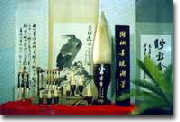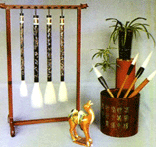 Among the various calligraphic tools, the writing brush is special to China. It represents one of the four treasures of study, which also include paper, ink and ink stone.
Among the various calligraphic tools, the writing brush is special to China. It represents one of the four treasures of study, which also include paper, ink and ink stone.
The writing brush has a long history in China. Legend has it that the brush was invented by Meng Tian (? - 210 BC), a general under the First Emperor of the Qin Dynasty (221-206BC), but primitive painted pottery contains decorative designs painted by tools resembling a brush. Clearly visible stains or brush marks remain in certain places on the pottery. This evidence suggests that the brush may have predated written language itself. The history of the Chinese brush can be traced back at least 6,000 years.
A brush comprises two parts: the head and shaft. The head is made of goat, wolf, rat or rabbit hair, which is softer than bamboo, a pencil, quill or ballpoint pen. The shaft is made of bamboo, wood, lacquer and porcelain, as well as some precious materials, including mother-of-pearl inlays, ivory and jade.
There are four types of famous writing brushes in China.
 1. The Hu Writing Brush, produced in Huzhou City, Zhejiang Province
1. The Hu Writing Brush, produced in Huzhou City, Zhejiang Province
The Huzhou writing brush falls into four categories. The first is made of goat hair, which is very flexible; the second, of brownish rabbit hair; the third, of stiff weasel hair; and the fourth is a mixture of goat and weasel hair, which is neither too flexible nor too stiff.
The workmanship of the brush is exquisite and complicated since it contains more than 120 processes -- from selecting materials to the finished products.
These brushes are especially handy both for painting and calligraphy. Due to its shaft, this type of brush is usually made of either red sandalwood or mottled bamboo, white porcelain or even with ivory. It is therefore regarded as the best-quality brush and the most exquisite handicraft.
2. The Xuan Writing Brush
The Xuan writing brush, together with the famous Xuan paper, is made in Jingxian County, Anhui Province. In ancient times, Jingxian County was under the jurisdiction of Xuanzhou Prefecture, where the product got its name.
Scholars of the Jin Dynasty (256-420) were especially fond of the Xuan brush. During the Tang (618-907) and Song (960-1279) dynasties, Xuanzhou became a writing-brush manufacturing center, and the Xuan brush was listed as a tribute to emperors.
At that time, folk artisans made a breakthrough in craftsmanship in selecting materials and polishing the shaft. Brushes were both sharp and neatly cut, and plump and smooth at the tip, enabling artists to write and draw freely. The Xuan brushes, made elaborately from brownish rabbit hair, are considered to be the best and come at a very high price.
 3. The Daiyuexuan Writing Brush
3. The Daiyuexuan Writing Brush
This writing brush was originally made by the venerable artisan Dai Yuexuan. Now, the brush is well known in Beijing for its high quality and elaborate craftsmanship. With the semi-manufactured writing brushes from Huzhou of Zhejiang Province as the main material, artisans used their immense skills to create a tool with a unique, sharp point, neat cut, with a smooth roundness and graceful stiffness at the tip. Because of these four characteristics, this brand enjoyed high prestige among artists and calligraphers.
Dai actually worked for a writing-brush workshop located by the east entrance to the Liulichang Cultural Street in Beijing 80 years ago. His brushes were much better than the brand from Huzhou, even though the same materials were used. Later on, the Daiyuexuan brand became renowned far and wide.
4. The Houdian Writing Brush, produced in Houdian Village
The manufacture of writing brushes came into existence in Houdian Village of Shandong Province during the reign of Emperor Yongle around 1404 of the Ming Dynasty, and flourished in the Qing Dynasty (1644-1911). In the early years of the Republic of China, almost all brushes sold at Beijing's famous Daiyuexuan and Hukaiwen stores were made by workers from Houdian. In 1952, the Houdian people built a large plant to pass on the traditional craftsmanship to the younger generation and to develop it.
The main materials for the brush come from animals' tails, such the wolf and civet, or ox ear hair, in more than 40 varieties. Hair collected in the winter is best for making high-quality brushes. Five main procedures are followed strictly to produce the brush correctly: washing and dying of the hair, carving characters on the shafts, packaging, and miscellaneous processes. Each of the five procedures contains about a dozen processes before a uniquely shaped brush with a special specification is made for different purposes.
Brushes made at Houdian Village are durable, offering a good combination of flexibility and stiffness, the ability to absorb more ink than others, and with little likelihood that the hair will out.
Without the writing brush, Chinese painting and calligraphy could not have achieved such distinct features, and thus would not have enjoyed such great success around the world. The writing brush makes great contributions to the dissemination of Chinese culture. With the development of social economy and culture, craftsmanship is continually improving, and the types of writing brushes are on the rise.
